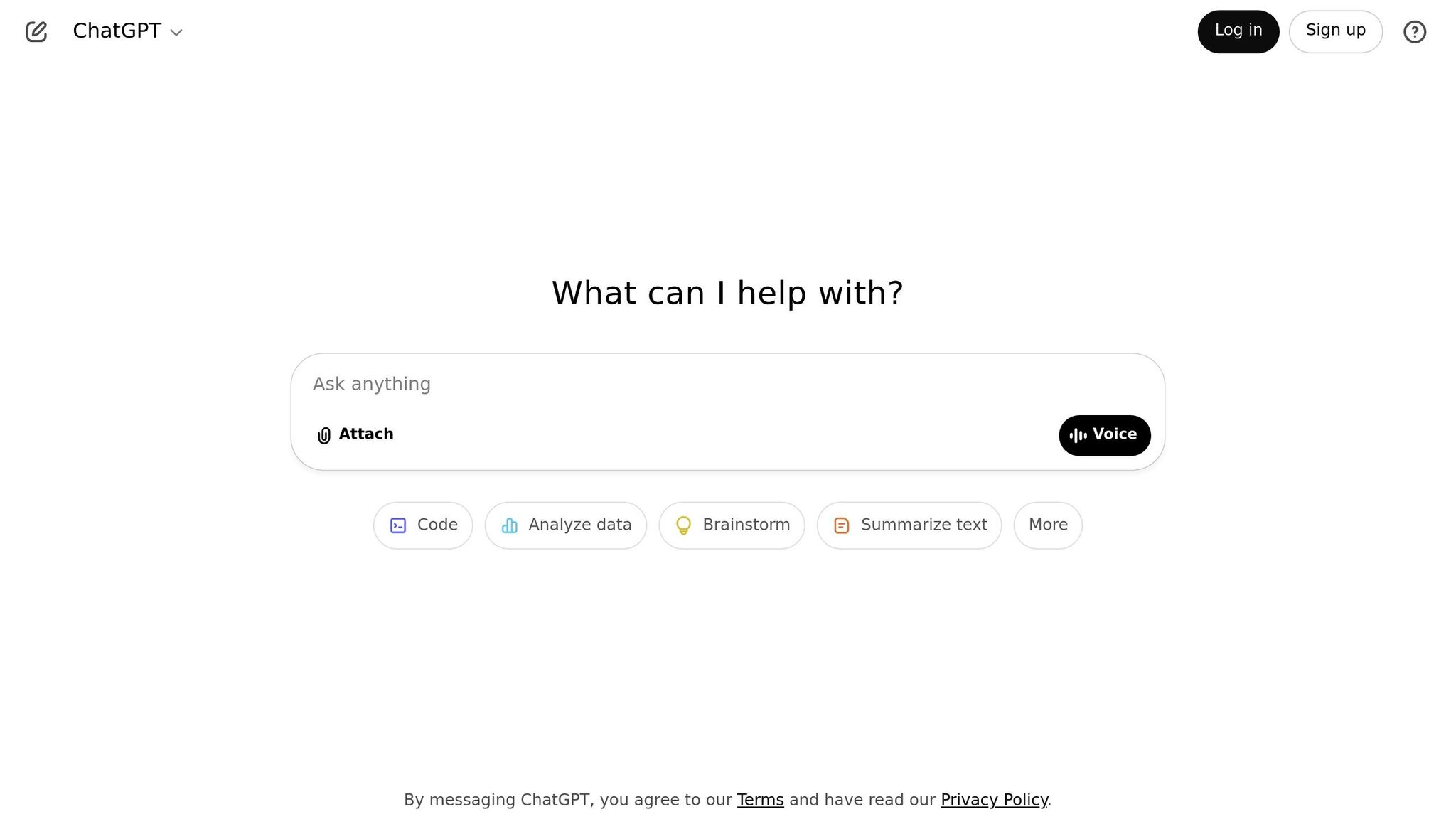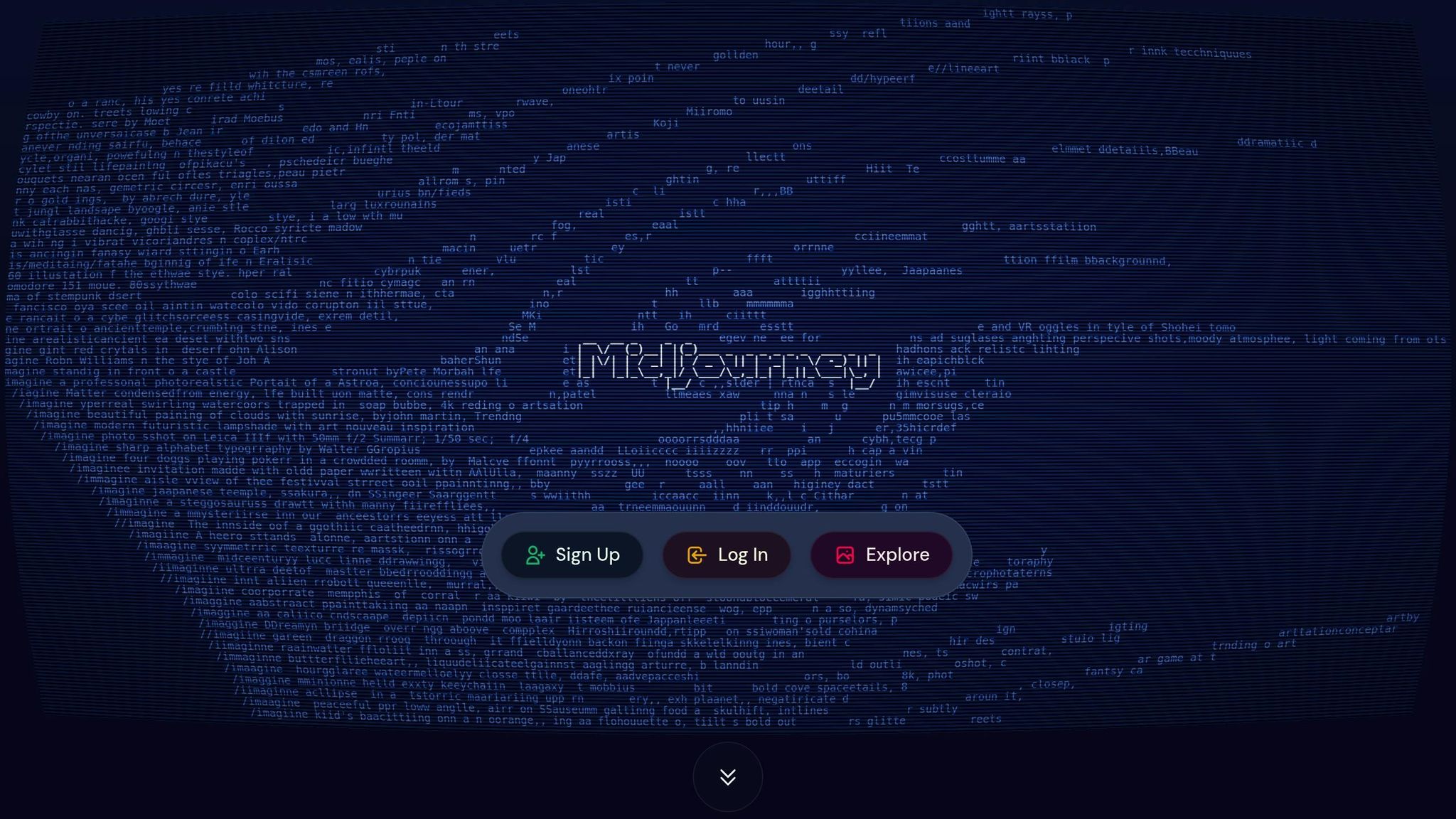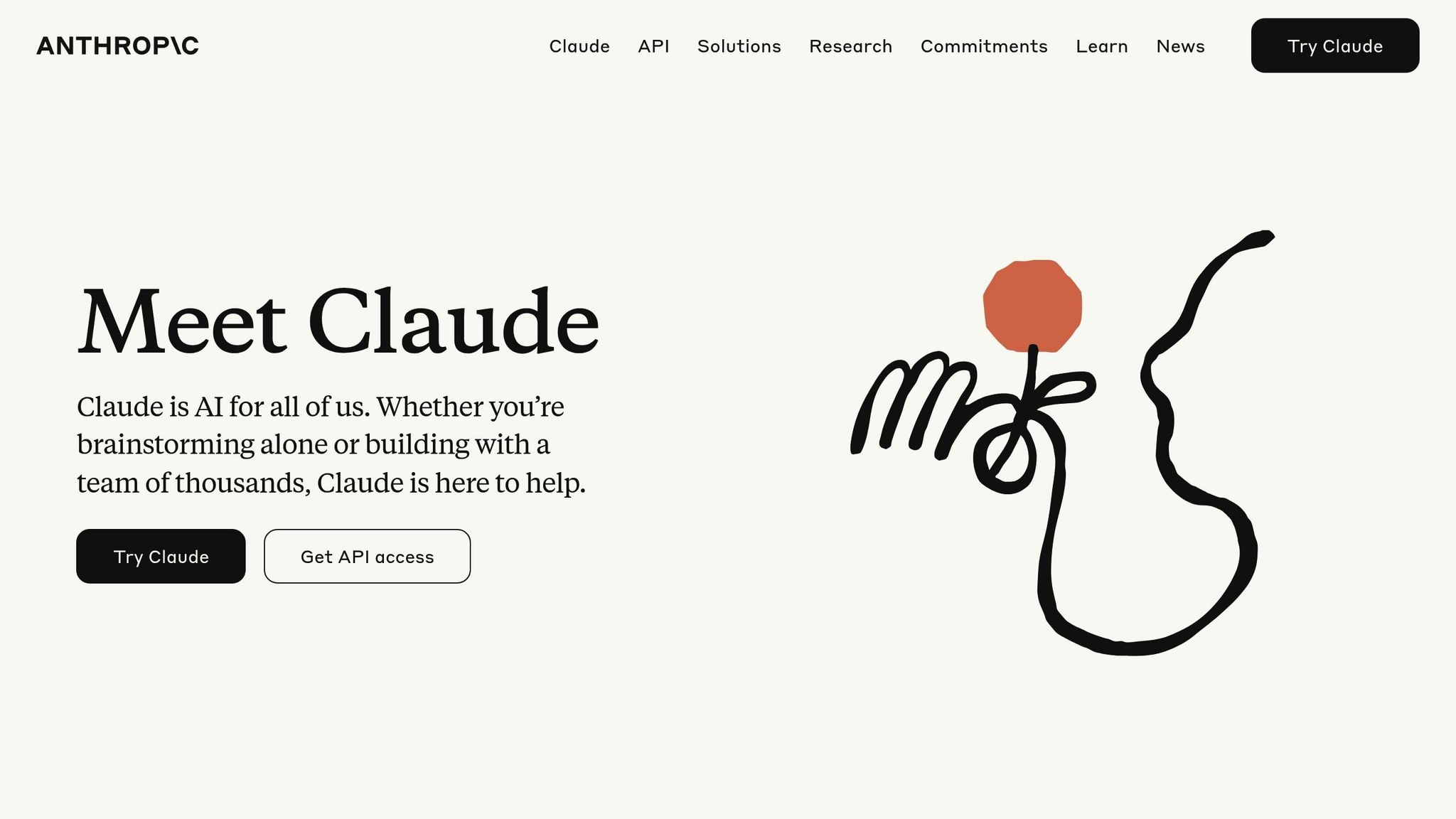
Most people use AI tools like ChatGPT for basic writing tasks. But there’s a whole world of advanced features that can boost your content game. These tools, when used effectively, can save time, increase productivity, and improve results by up to 40%. Here’s what you need to know:
| Tool | Strengths | Weaknesses | Best For |
|---|---|---|---|
| ChatGPT | Versatile for text, images, and tasks | Can feel repetitive at times | Beginners, quick tasks |
| Midjourney | High-quality visuals, artistic styles | No text generation, Discord-only | Visual branding, creative projects |
| Claude | Long-form writing, advanced analysis | No image generation | Complex projects, coding |
AI isn’t just about saving time - it’s about working smarter. Dive in to learn how to unlock these tools for your business or creative projects.
Getting great results from AI often comes down to how you ask for them. That’s where prompt engineering comes in - the practice of crafting specific inputs to guide AI toward producing exactly what you need. Think of it as the bridge between vague requests and tailored, high-quality outputs. For example, instead of simply asking, "write a blog post about marketing", advanced techniques help refine your input to shape the AI’s response into something truly useful and relevant.
Refining prompts is a bit like having a conversation. Rarely will a single, generic request hit the mark on the first try. Instead, you tweak, clarify, and iterate until the results align with your vision.
In fact, pilot studies show that effective prompt engineering can increase efficiency by up to 40%. Once you’ve mastered this interactive approach, you can take it further by employing role-based prompts.
Role prompting takes refinement to the next level by assigning the AI a specific role or perspective. This method transforms generic outputs into expert-level insights tailored to your needs. For example, rather than asking for broad advice, you could say:
"Act as a senior digital marketing strategist with 10 years of experience in B2B SaaS companies. You specialize in conversion optimization and have helped companies increase their trial-to-paid conversion rates by 40% or more."
As Kai_ThoughtArchitect, a highly regarded commenter, explains:
"Think of 'role' not as assigning a persona. For me, it's about defining how the AI should engage in the conversation."
A study using GPT-3.5 demonstrated how effective this strategy can be. Accuracy on the AQuA dataset jumped from 53.5% to 63.8% when using a two-stage approach that included Role-Setting and Role-Feedback Prompts. The key is to be clear about the role you’re assigning and to refine your prompts further based on the AI’s responses.

If creating custom prompts feels daunting, there’s good news: you don’t have to start from scratch. Tools like God of Prompt offer a massive library of over 30,000 pre-designed AI prompts tailored to specific needs, from marketing and SEO to copywriting. These templates save time and eliminate much of the trial and error.
As one satisfied user shared:
"These prompts are absolutely amazing! I have wasted so much time and money on other prompts that I was about to give up hope. My search is over! I only wish I found God of Prompt sooner. These prompts provide immediate value."
The Complete AI Bundle - which includes the ChatGPT Mega-Prompt Bundle ($150), Midjourney Prompt Bundle ($67), and Custom GPTs Toolkit ($67) - offers lifetime access to business-focused templates that can save as much as 20 hours per week.
What makes these collections stand out is their focus on practical applications. They’re not just generic templates; they’re specifically designed for professionals like content creators, marketers, and entrepreneurs. Plus, with lifetime updates, these tools evolve alongside advancements in AI, ensuring you always have access to the latest strategies. This organized, user-friendly approach makes advanced prompt engineering accessible, no matter your experience level.

ChatGPT is more than just a conversational tool - it offers features that can elevate the way content creators plan, organize, and produce their work. By exploring some of its lesser-known capabilities, you can streamline workflows and achieve more polished results with less effort.
Custom GPTs are essentially tailored versions of ChatGPT designed to handle specific tasks. Whether it’s crafting product descriptions, generating social media posts, or writing email campaigns, these models adapt to your needs with precision.
"Custom GPTs are personalised versions of OpenAI's ChatGPT that you can configure to perform specific tasks according to the output you need." - Ellie Piper, Web Hive Digital
The beauty of Custom GPTs lies in their ability to align with your brand voice, content templates, and even product data. Once trained, they produce outputs that fit your style without requiring repeated instructions.
Meanwhile, Projects Mode introduces a way to keep everything organized. It groups related chats, files, and instructions into one centralized hub. This is especially helpful when juggling multiple clients or content types, as you can set project-specific guidelines that override general ones.
"Projects provide a new way to group files and chats for personal use, simplifying the management of work that involves multiple chats. Projects keep chats, files, and custom instructions in one place. Use them for ongoing work, or just to keep things tidy." - OpenAI
In 2024, Seer Interactive showcased the power of these tools by analyzing 167 recurring deliverables and creating Custom GPTs for around 80% of their tasks. They even released Base Level Custom GPTs, such as a Slide Deck Outline GPT, which helped teams produce presentations faster and with more clarity.
Here’s how these features differ: Custom GPTs are perfect for creating specialized, shareable tools that integrate training data, while Projects Mode is ideal for personal organization - keeping everything in one place but not designed for sharing.
While these tools enhance task management, Canvas Mode reimagines how you plan and visualize content.
Canvas Mode steps away from the traditional chat interface, offering a visual editor tailored for writing and coding projects that require detailed revisions. Instead of relying on back-and-forth messages, you can collaborate directly within an editor where ChatGPT has full context of your project.
You can highlight specific sections to refine tone, expand ideas, or tweak paragraphs, eliminating unnecessary guesswork. Canvas also tracks every change, making version control effortless - a lifesaver when testing out different approaches or responding to client feedback.
For content creators, Canvas Mode is especially useful for planning long-term strategies. For example, you can create a weekly content calendar by setting up sections for each day or category, then rearrange and prioritize items visually as your plans evolve. Event planning becomes easier, too. Simply upload details from various sources, and ChatGPT can merge and refine them into a cohesive outline.
Beyond text, Canvas Mode supports more advanced capabilities. You can embed code for calculations, track goals with charts, and emphasize milestones with formatting like bold text. It’s currently available on Web, Windows, and MacOS, with mobile support coming soon.
These tools pave the way for more business-oriented applications of ChatGPT.
When it comes to business content, the key to success is crafting highly detailed prompts. This ensures ChatGPT delivers outputs that are nearly ready for use.
For instance, when creating marketing materials, don’t just ask for "a social media post about our product." Instead, provide details about your target audience, the platform where it will be posted, your brand voice, and the call-to-action you want.
Developing business plans also benefits from step-by-step prompting. Start with broader sections like market analysis or competitor research, then refine each part with follow-up questions. This approach ensures thorough and actionable results, unlike trying to generate everything in one go.
Always verify any numbers or facts included in business-focused content. ChatGPT excels at structure, creativity, and tone, but human oversight is essential for ensuring accuracy, particularly with financial data or regulatory details.

Midjourney takes visual content creation to the next level with features that go beyond simple image generation. These tools provide content creators with more control over their visuals, helping ensure brand consistency and delivering polished, professional results.
By default, Midjourney applies automatic aesthetic tweaks to every image, which can sometimes interfere with your original vision. RAW mode changes this dynamic by dialing back these automatic adjustments, allowing the AI to focus more on the specific details you include in your prompt. This gives you greater control over the final output, making it easier to achieve highly specific or realistic results. However, crafting detailed and clear prompts becomes critical - vague instructions might lead to less visually appealing images. RAW mode is available starting with Midjourney versions 5.1 and later and can be activated by adding --raw to your prompt or enabling it in the settings panel. Pairing RAW mode with stylize options can help strike the right creative balance.
The stylize parameter functions like a creative control knob, adjusting how much artistic freedom Midjourney applies to your image. Lower values (0–100) stick closely to your prompt, while higher values (500–1000) allow the AI to take more creative liberties. The default setting is 100, but experimenting with different levels can help you refine a consistent visual style that aligns with your brand.
"Adjusting the stylize parameter offers you the opportunity to customise the styling of your generated images. It can also serve as an avenue for playful exploration." - XEN Create
In March 2025, Logome.ai published an in-depth guide on using Midjourney for logo design. Their method involved integrating style elements, color schemes, and mood descriptors into prompts, emphasizing the importance of refining designs through feedback to maintain brand cohesion. For detailed brand work, start with lower stylize values to control elements like colors, shapes, and intricate details. On the other hand, higher stylize values can enhance projects that benefit from a more artistic touch. Interestingly, longer prompts often produce similar results across stylize values between 500 and 1000, making prompt clarity even more important.
To complement these advanced tools, God of Prompt offers a library of over 10,000 pre-tested Midjourney prompts that simplify the creative process. These templates are designed to work seamlessly with features like RAW mode and stylize parameters, helping you achieve professional-quality visuals more efficiently. This resource is particularly useful when working with Midjourney V6, which excels at interpreting detailed instructions and handling longer prompts. The latest version also introduces improved text-handling capabilities, making it ideal for creating marketing materials that include text elements.
When incorporating text into your visuals, enclose the text in quotes, use shorter words, and repeat key phrases to improve clarity. Combining these techniques with --stylize and --style raw can further enhance your results. God of Prompt's organized templates save time by offering proven starting points that you can customize to meet your brand's specific needs. This is especially helpful in RAW mode, where precise prompts are essential for achieving the desired look and feel.
The Midjourney Bundle includes access to these curated prompts as well as detailed guides on using advanced features like stylize parameters and RAW mode. Together, these tools and educational resources enable creators to go beyond basic image generation, unlocking the potential for sophisticated and impactful visual branding.

Claude offers a standout approach to content analysis, going beyond the basics of content generation. Its advanced analytics dive deep into your existing material, competitor strategies, and audience behavior to deliver actionable insights. These insights help shape smarter, data-driven content strategies.
Claude's ability to work in multiple languages makes it a powerful tool for businesses looking to connect with global audiences. It handles input and output in most languages supported by standard Unicode characters, excelling in widely spoken ones and performing impressively even in languages with limited digital resources. In fact, Claude outperforms traditional translation tools like NLLB (No Language Left Behind) and Google Translate. This capability is essential for businesses expanding into international markets, as it allows for the creation of content that resonates with local audiences rather than relying on direct translations.
| Feature | Claude AI | ChatGPT | Google Gemini |
|---|---|---|---|
| Context Understanding | Strong | Moderate | Moderate |
| Conversational Flow | Smooth | Moderate | Moderate |
| Cultural Nuance Awareness | High | Moderate | Moderate |
To get the most out of Claude's multilingual features, specify the desired language for better accuracy. For content that feels more natural, ask Claude to use "idiomatic speech as if it were a native speaker" instead of basic translations. This approach makes the content feel authentic to native speakers. Claude's real-time translation abilities are particularly useful for live conversations, customer support, and international meetings. Businesses can also use this feature to analyze feedback from diverse regions, track global trends, and craft localized strategies that account for cultural subtleties. These multilingual capabilities create opportunities for inclusive and thoughtful content creation.
Claude sets itself apart by prioritizing ethical standards in content creation. It uses Constitutional AI to minimize harmful outputs and ensure content aligns with ethical guidelines. Anthropic conducted an extensive study involving 700,000 anonymized conversations to examine how Claude reflects values in practical scenarios. The study identified 3,307 unique values, grouped into five categories: Practical, Epistemic, Social, Protective, and Personal. Notably, Claude strongly supported user values in 28.2% of cases and resisted them in only 3%.
"Our hope is that this research encourages other AI labs to conduct similar research into their models' values. Measuring an AI system's values is core to alignment research and understanding if a model is actually aligned with its training." - Saffron Huang, Member of Anthropic's Societal Impacts team
For content creators, this ethical framework means you can rely on Claude to identify bias in your content and suggest more inclusive alternatives. It can flag language that might alienate certain groups and recommend adjustments to meet accessibility standards. However, it's still crucial to review AI-generated content for plagiarism and regularly assess it for ethical concerns and accuracy. Past controversies, like the backlash against Lensa AI in 2022 for failing to credit artists whose work trained its models, highlight the importance of maintaining ethical practices. Claude's transparent approach helps creators avoid similar issues, ensuring content strategies remain fair and inclusive.
Claude excels in identifying content gaps, conducting keyword research, and refining audience targeting. It also analyzes competitor strategies to uncover effective approaches. One standout feature is its ability to analyze audience behavior, helping determine the best platforms and posting times. For example, Sprout Social saved 72 hours per quarter on performance reporting by integrating AI tools into their workflows in March 2023.
Claude can also pinpoint outdated information, broken links, and underperforming assets, offering specific suggestions for improvement based on current SEO practices and website performance. It helps with technical optimization by generating schema markup for various content types and ensuring business listings have consistent NAP (Name, Address, Phone) details. By identifying patterns and trends in large datasets, Claude enables businesses to make informed decisions about content direction, audience focus, and resource allocation.
In 2024, a global survey showed that 42% of marketers use AI tools daily or weekly for content creation. Additionally, a Sprout Social Pulse Survey from Q2 2023 revealed that 71% of social marketers have incorporated AI into their workflows, with 82% reporting positive results. These capabilities allow content creators to refine their strategies with precise, AI-driven insights.
Picking the right AI tool can make a huge difference in how efficiently you create content. Each platform has its own strengths and challenges, so understanding these can help you choose the best fit for your needs.
Every AI tool shines in certain areas but also comes with limitations. Here's a quick breakdown to help you understand where each one excels and where it might fall short:
| Tool | Strengths | Weaknesses | Best For |
|---|---|---|---|
| ChatGPT | Offers a variety of features like image generation, voice capabilities, web browsing, and task automation | Can produce bland content; overuses bullet points; weaker coding abilities | Quick searches, versatile content, beginners |
| Midjourney | High-quality images, artistic styles, Discord integration, and flexible generation modes | Focused solely on visuals; requires Discord; lacks text generation | Visual branding, marketing materials, creative projects |
| Claude | Natural writing style, excellent coding support, and a massive 200K context window for handling large content | No web browsing or image generation; limited by knowledge cutoffs | Long-form writing, complex analysis, coding projects |
ChatGPT is a jack-of-all-trades platform. While it’s incredibly versatile, it might occasionally produce content that feels uninspired or overly reliant on bullet points unless specifically guided.
Midjourney, on the other hand, is a powerhouse for visual content. It operates through Discord and offers various generation modes like Fast, Relax, and Turbo, catering to different workflow needs. It’s especially strong in maintaining character consistency and applying artistic reference styles. Pricing for Midjourney ranges from $10 to $120 per month for enterprise plans.
Claude stands out as a text-focused tool with a natural writing style, advanced coding capabilities, and an impressive ability to handle extensive documents thanks to its large context window. Built on a Constitutional AI framework, it’s designed to encourage ethical content creation.
The best tool for you depends on your specific content goals. Experimenting with features and aligning them with your workflow often leads to better results than relying solely on one platform.
For those who need a partner in writing, coding, or brainstorming, Claude’s nuanced understanding and ability to handle detailed tasks make it a solid choice. Marketing teams and small businesses might lean toward ChatGPT for its adaptability - it combines web browsing for fact-checking with built-in image generation, reducing the need for separate tools.
If your focus is on visuals, Midjourney is a go-to for creating compelling imagery. For instance, 47% of respondents aged 18–34 view AI-generated visuals as legitimate art, making it a great option for e-commerce, social media, and creative studios.
Many content creators use a combination of tools to maximize efficiency. For example, Claude can handle in-depth writing projects, while ChatGPT can assist with quick searches or generate visuals. Midjourney can then take over for creating high-quality images. This multi-tool strategy allows you to play to each platform’s strengths while minimizing their weaknesses.
To streamline your workflow further, the God of Prompt Bundles brings together the best of these tools. With over 30,000 optimized prompts, the bundles unlock advanced features and hidden capabilities across platforms.
This system is particularly effective when managing multi-phase projects. For instance, you might use Claude prompts for research and analysis, switch to ChatGPT for drafting and SEO optimization, and then rely on Midjourney prompts for visuals - all while maintaining a cohesive style. Accessing these prompts through Notion also allows teams to customize collections for specific projects or clients, saving time and ensuring consistent quality.
AI offers untapped potential that can redefine how businesses approach content creation. While 77% of companies are experimenting with AI in some way and 35% are actively using it, the real advantage lies in mastering its advanced capabilities. Businesses that integrate these advanced features report impressive results, including a 15–20% boost in ROI and up to 40% gains in productivity. Additionally, 93% of marketers now create content faster, and 90% make decisions more quickly thanks to AI. These figures highlight the pressing need to embrace advanced AI tools.
By building on the strategies shared earlier, successful marketers and creators are tapping into optimized prompts to unlock AI's full potential. For example, the God of Prompt Complete AI Bundle provides over 30,000 specialized prompts tailored for platforms like ChatGPT, Claude, and Midjourney. These prompts are designed to reveal capabilities that often go unnoticed, giving users a competitive edge.
Investing in such tools translates into measurable advantages. With AI adoption growing at a 37.3% annual rate and 83% of companies making it a priority, early adopters position themselves to lead the charge. For $150, the Complete AI Bundle offers lifetime access to continually updated resources, ensuring users stay ahead in this rapidly evolving space.
Chelse Hensley, a Social Media Strategist at Visme, sums up the benefits perfectly:
"With the help of AI, I'm able to take tedious, time-consuming tasks and turn them into fast solutions."
Advanced AI capabilities not only streamline workflows but also open doors to creative opportunities that were once out of reach. Combining tools like ChatGPT's Custom GPTs, Midjourney's RAW mode, and Claude's expansive context processing can help businesses scale their content efforts without losing quality or brand consistency. Companies that treat AI as a strategic asset, rather than just a productivity tool, will lead the way in content creation for years to come.
With resources like the God of Prompt's curated collections and lifetime updates, you're not just purchasing a set of prompts - you’re investing in a system designed to keep you ahead of the competition. AI is no longer just an option; it’s the key to staying relevant and thriving in the ever-changing world of content strategy.
To get the most out of AI-generated content using role-based prompts, start by specifying the role you want the AI to assume, like a social media strategist, content marketer, or technical writer. This step ensures the AI tailors its responses to match the tone, expertise, and style you need.
Next, always provide context first. Share your goals, audience details, or project specifics before assigning the role. For instance, you could say, "Act as a social media strategist and create Instagram captions for a fitness brand aimed at young adults." This way, the AI can craft content that aligns with your objectives and connects with your audience.
When you combine clear context with a defined role, the AI can produce relevant, high-quality content that not only saves you time but also sparks creativity.
Midjourney's RAW Mode lets you take the reins when it comes to the final look of your images. By dialing back automatic aesthetic tweaks, it creates visuals that feel more natural, photorealistic, and true to your original prompt. This makes it a go-to option for projects where precision, intricate details, or a specific style are key.
When crafting prompts for RAW Mode, clarity is everything. Keep your instructions focused and to the point. Highlight the essential elements - like the style, subject, and mood you’re aiming for. Using precise descriptors and combining ideas thoughtfully can lead to more accurate and imaginative results. The more deliberate you are with your prompt, the closer the output will match your vision!
Claude offers powerful tools to refine your content strategies by delivering practical insights into how your audience interacts with your content. Through machine learning, it uncovers patterns in audience preferences - like trending topics, the most engaging content formats, and the ideal times to publish for peak interaction.
On top of that, Claude can handle tasks such as customer segmentation and forecasting audience behavior. This allows you to craft tailored content that resonates more effectively with your audience. By leveraging this data-driven method, you can not only enhance engagement but also fine-tune your content strategy for stronger outcomes.





